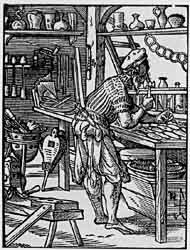
|
How
were stained glass windows made?
The earliest examples of windows with
figurative scenes are known from St.Remi in Reims from around the
year 1000.
Glass is a mixture of silicic acid and metal oxides, which
solidifies after melting. It consists of up to 70% silicic
acid, with up to 20% alkali's for durability and soda for
fluidity. |
The only
colours available in the Middle Ages were saffron-yellow,
purplish-red, green, blue and copper-red. Miniatures often provided
the models for the stained glass windows. One cut the small coloured
glass panes to size and then painted them with black solder/flux?
(Schwarzlot), a mixture of iron and copper powder. After 1300 silver
solder/flux? (Silberlot) was also available, which allowed for a new
range of colours, for example light yellow and reddish-yellow. The
colours were melted onto the glass.
The panes could be leaded as soon as they had cooled. The
pliable lead strips could be easily bent to shape. The lead grid had
to be carefully applied, as it provided the frame for the pictoral
design. Any cracks were then filled with clay. Generally the
complete window would then be inserted into the masonry window frame
and fixed with mortar.
Colleagues from the Landesdenkmalamt (LDA) Baden-Württemberg
and the stone-mason's workshop of Cologne Cathedral have produced
a comprehensive report on the restoration and care of the medieval
stained glass windows from the church St.Dionys in Esslingen. The
results of their work can be read in the LDA's quarterly News
Journal, "Denkmalpflege in Baden-Württemberg" (
1/1997), or can be accessed on the server "Denkmalpflege in
Baden-Württemberg": P.
Berkenkopf u. O. Wölbert, Dokumentation und Restaurierung
der mittelalterlichen Glasfenster aus St.Dionys in Esslingen.
(German only) |